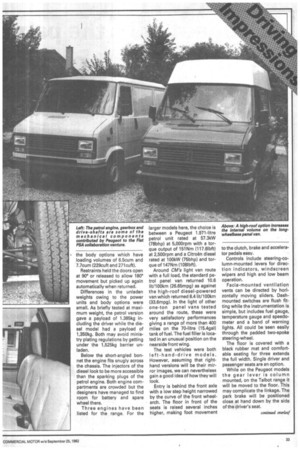Peugeot joins the panel with the Talbot Express
Page 26

Page 27

If you've noticed an error in this article please click here to report it so we can fix it.
TALBOT, the Peugeot-owned car manufacturing side of what used to be Dodge, is about to launch a new panel van range — the Talbot Express — into Britain. It will replace the recently expired PBSeries.
Fiat and the Peugeot Citroen Group {PSA) collaborated both in development and production. They also agreed on territorial marketing arrangements which give Italy to the Italians, France to the French and leaving the rest of Europe as a free-for-all with the exception of the UK. In Britain, Peugeot with its Talbot subsidiary, is deemed to have an additional marketing advantage.
The new van range, which will be first shown at the NEC Motor Show in October, is based on the Peugeot J5 already selling well in France where front-wheel drive has long been accepted as the norm for lightweight panel vans. The concept may still be viewed with apprehension here but from an operational point of view it gives great advantages, allowing a very low platform height and consequently larger interior capacity than is possible with conventional rear-wheeldrive vehicles.
Both short and long-wheelbase models giving payloads of 1,000kg and 1,300kg will make up the range. Recently CM got hold of left-hand-drive petrol and diesel versions of the heavier model equipped with a wide, sliding-side load door. The opening was more than 1m (3.2ft) across; large enough to accept a standard-sized pallet.
The body of the diesel model was enlarged by a high-roof option increasing the internal floor to roof dimension to 1.84m (6ft) — 0.32m (1ft) more than for the basic van body.
A long platform length of 2.67m (8ft 9in) had intrusions made by the narrow wheelarches covering the single rear wheels, diminishing the usable 1.68m (5.5ft) width but serviced by full-height rear door suiting the body options which have loading volumes of 6.5cum and 7.7cum (229cuft and 271cuft).
Restraints held the doors open at 90° or released to allow 180° movement but picked up again automatically when returned.
Differences in the unladen weights owing to the power units and body options were small. As briefly tested at maximum weight, the petrol version gave a payload of 1.385kg including the driver while the diesel model had a payload of 1,350kg. Both may avoid ministry plating regulations by getting under the 1,525kg barrier unladen.
Below the short-angled bonnet the engine fits snugly across the chassis. The injectors of the diesel look to be more accessible than the sparking plugs of the petrol engine. Both engine compartments are crowded but the designers have managed to find room for battery and spare wheel there.
Three engines have been listed for the range. For the larger models here, the choice is between a Peugeot 1.971-litre petrol unit rated at 57.3kW (78bhp) at 5,000rpm with a torque output of 151Nm (117.6Ibft) at 2,500rpm and a Citroen diesel rated at 100kW (75bhp) and torque of 147Nm (108Ibft).
Around CM's light van route with a full load, the standard petrol panel van returned 10.6 lit/100km (26.65mpg) as against the high-roof diesel-powered van which returned 8.4 lit/100km (33.6mpg). In the light of other one-ton panel vans tested around the route, these were very satisfactory performances giving a range of more than 400 miles on the 70-litre (15.4gal) tank of fuel. The fuel filler is located in an unusual position on the nearside front wing.
The test vehicles were both left-hand-drive models. However, assuming that righthand versions will be their mirror images, we can nevertheless gain a good idea of how they will look.
Entry is behind the front axle with a low step height narrowed by the curve of the front wheelarch. The floor in front of the seats is raised several inches higher, making foot movement to the clutch, brake and accelerator pedals easy.
Controls include steering-column-mounted levers for direction indicators, windscreen wipers and high and low beam operation.
Facia-mounted ventilation vents can be directed by horizontally moving sliders. Dashmounted switches are flush fitting while the instrumentation is simple, but includes fuel gauge, temperature gauge and speedometer and a band of warning lights. All could be seen easily through the padded two-spoke steering-wheel.
The floor is covered with a black rubber mat and comfortable seating for three extends the full width. Single driver and passenger seats are an option.
While on the Peugeot models the gear lever is column mounted, on the Talbot range it will be moved to the floor. This may complicate the linkage. The park brake will be positioned close at hand down by the side of the driver's seat.












































